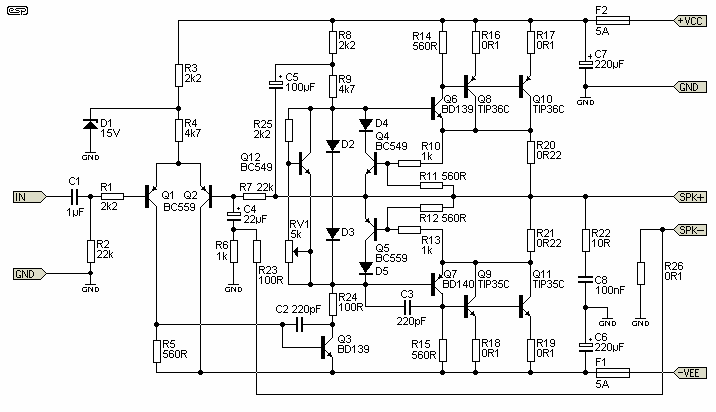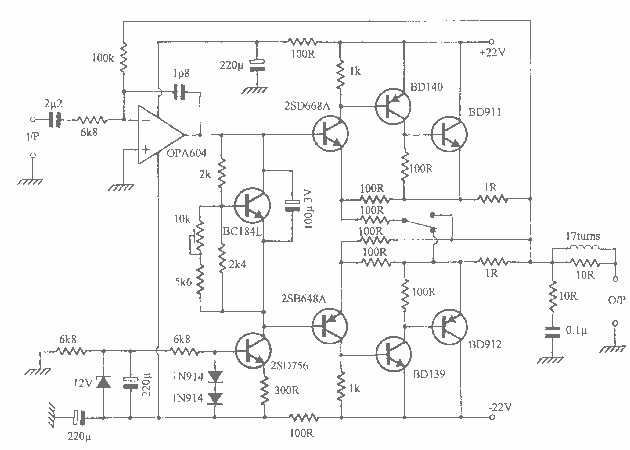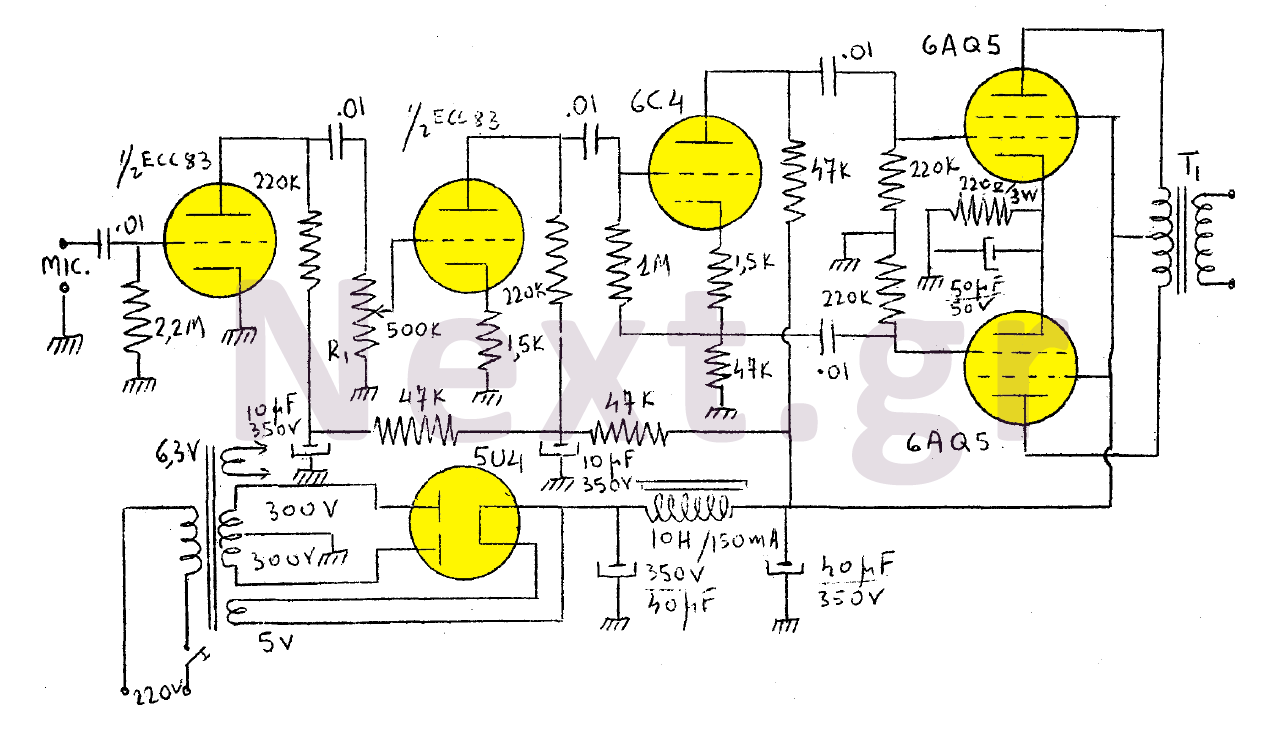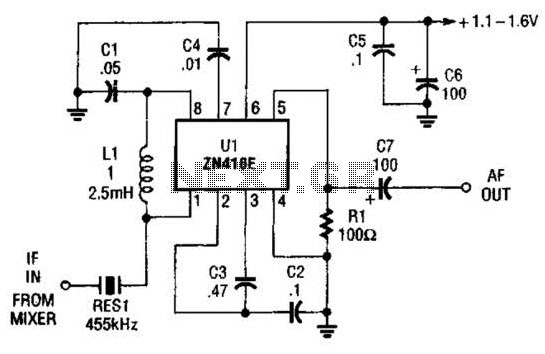
Amplifier Timer

This circuit deactivates an amplifier or other devices when a low-level audio signal at its input is absent for at least 15 minutes. By pressing P1, the device is activated, supplying power to any appliance connected to SK1. The input audio signal is amplified and squared by IC2A and IC2B, and the signal is monitored by LED D4. When D4 lights up, even briefly, C3 is reset, and counting restarts. Pin 2 of IC3 stays low, keeping both transistors on, which allows the relay to operate. If no signal is detected at the input after a 15-minute delay, IC3 completes its count, and pin 2 goes high. This causes Q1 and Q2 to stop conducting, which turns off the relay. Consequently, the device and any appliances connected to SK1 are completely powered down. C5 and R9 reset IC3 upon power-on, while P2 provides a means to switch off the device at any time.
This circuit operates as an automatic audio signal detector and relay controller. It is designed to monitor audio signals and manage power to connected devices based on the presence or absence of these signals. The circuit begins its operation when the user presses switch P1, which activates the system and allows power to flow to the output terminal SK1.
The core of the circuit utilizes operational amplifiers IC2A and IC2B to amplify and square the incoming audio signal, ensuring that even low-level signals can be effectively processed. The output of this amplification is visually indicated by LED D4, which serves as a status indicator for the presence of an audio signal. When the audio signal is detected, even momentarily, the capacitor C3 is reset, which restarts the timing sequence necessary for the circuit's operation.
The timing mechanism is controlled by integrated circuit IC3. Under normal conditions, pin 2 of IC3 remains low, which keeps transistors Q1 and Q2 conducting. This allows the relay to remain activated, thus maintaining power to SK1 and any connected devices. However, if the audio signal is absent for 15 minutes, IC3 will conclude its timing sequence, causing pin 2 to transition to a high state. This transition turns off transistors Q1 and Q2, resulting in the relay deactivating and cutting power to the connected devices.
Additional components C5 and R9 ensure that IC3 is properly reset when the circuit is powered on, providing reliable operation from the start. The inclusion of switch P2 allows the user to manually turn off the device at any time, providing flexibility in operation. This circuit design is particularly useful in applications where automatic power management based on audio signal detection is desired, enhancing energy efficiency and device longevity.This circuit turns-off an amplifier or any other device when a low level audio signal fed to its input is absent for 15 minutes at least. Pushing P1 the device is switched-on feeding any appliance connected to SK1. Input audio signal is boosted and squared by IC2A & IC2B and monitored by LED D4. When D4 illuminates, albeit for a very short peak, I C3 is reset and restarts its counting. Pin 2 of IC3 remains in the low state, the two transistors are on and the relay operates. When, after a 15 minutes delay, no signal appeared at the input, IC3 ends its counting and pin 2 goes high. Q1 & Q2 stop conducting and the relay switches-off. The device is thus completely off as also are the appliances connected to SK1. C5 & R9 reset IC3 at power-on. P2 allows switch-off at any moment. 🔗 External reference
This circuit operates as an automatic audio signal detector and relay controller. It is designed to monitor audio signals and manage power to connected devices based on the presence or absence of these signals. The circuit begins its operation when the user presses switch P1, which activates the system and allows power to flow to the output terminal SK1.
The core of the circuit utilizes operational amplifiers IC2A and IC2B to amplify and square the incoming audio signal, ensuring that even low-level signals can be effectively processed. The output of this amplification is visually indicated by LED D4, which serves as a status indicator for the presence of an audio signal. When the audio signal is detected, even momentarily, the capacitor C3 is reset, which restarts the timing sequence necessary for the circuit's operation.
The timing mechanism is controlled by integrated circuit IC3. Under normal conditions, pin 2 of IC3 remains low, which keeps transistors Q1 and Q2 conducting. This allows the relay to remain activated, thus maintaining power to SK1 and any connected devices. However, if the audio signal is absent for 15 minutes, IC3 will conclude its timing sequence, causing pin 2 to transition to a high state. This transition turns off transistors Q1 and Q2, resulting in the relay deactivating and cutting power to the connected devices.
Additional components C5 and R9 ensure that IC3 is properly reset when the circuit is powered on, providing reliable operation from the start. The inclusion of switch P2 allows the user to manually turn off the device at any time, providing flexibility in operation. This circuit design is particularly useful in applications where automatic power management based on audio signal detection is desired, enhancing energy efficiency and device longevity.This circuit turns-off an amplifier or any other device when a low level audio signal fed to its input is absent for 15 minutes at least. Pushing P1 the device is switched-on feeding any appliance connected to SK1. Input audio signal is boosted and squared by IC2A & IC2B and monitored by LED D4. When D4 illuminates, albeit for a very short peak, I C3 is reset and restarts its counting. Pin 2 of IC3 remains in the low state, the two transistors are on and the relay operates. When, after a 15 minutes delay, no signal appeared at the input, IC3 ends its counting and pin 2 goes high. Q1 & Q2 stop conducting and the relay switches-off. The device is thus completely off as also are the appliances connected to SK1. C5 & R9 reset IC3 at power-on. P2 allows switch-off at any moment. 🔗 External reference





